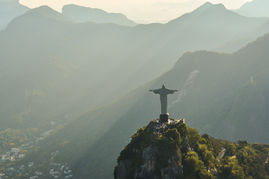
"Ordem e Progresso"
Introduction
Brazil is the largest country in South America, occupying half of the continent's landmass. It is the fifth largest country in the world, bordered by the Atlantic Ocean and sharing borders with every South American country except Chile and Ecuador. Brazil is renowned for its diverse landscapes, including the Amazon Rainforest, which contains the world's largest river system and the most extensive virgin rainforest
History
Brazil, the largest country in South America, has a deep and fascinating history. Before the arrival of European settlers specifically Portuguese, there were many communities of indigenous people, there were an estimated amount of between 2 million and 6 million across Brazil, including the Tupian-speaking Indians who occupied the coasts. They did not develop states like larger civilizations, but they established communities with farmers, hunters, and gatherers (Britannica). On April 22, 1500, Portugal colonized Brazil, led by Pedro Álvares Cabral. Portugal claimed it after they had signed a treaty with Spain known as the Treaty of Tordesillas to divide the New World, with Portugal claiming the east and Spain declaring the west (Britannica). Brazil was originally named Vera Cruz, but it was renamed Brazil due to its abundant Brazilwood (Britannica). Which is an orange-red tree, that is commonly used for making bows or sometimes string instruments (“Brazilwood Facts for Kids”). Portugal established their permanent settlements in 1532 and introduced many things to the Brazilian people. For instance, the Portuguese brought African slaves to produce labor on sugarcane plantations (Britannica). Portugal maintained control over Brazil for 300 more years, before Brazil gained its independence from Portugal on September 7, 1822, led by Dom Pedro I, who became their first emperor (Britannica). Compared to other Latin American countries, Brazil achieved independence with relatively little violence. Only with one war lasting around 2 years. In 1888 after independence, Dom Pedro II decided to abolish slavery. Following
this decision, around 700,000 slaves were freed in Brazil (Britannica). In addition to abolishing slavery, later in 1942, Brazil joined World War II, joining the allied forces. Going against Fascist Italy and Nazi Germany. Later during the 19th century and early 20th century, Brazil saw a big increase in European immigration mainly Italian (Britannica). Nowadays the Brazilian population consists of people of European descent mainly from Portugal and Italy, indigenous people, divided into 230 different cultural groups, and lastly people of African descent (Britannica). The people of African descent in Brazil are known to bring the country the most impact in arts and culture, specifically music and dancing. This diversity is mainly from the country's history. Historically as said before the people of African descent were slaves used for labour to produce sugarcane. This is a similar historical connection when looking at Brazil's European population. Historically the Portuguese colonized Brazil bringing in most of the European population still to this day (Britannica). Finally, the indigenous presence in Brazil originates from their original settlement and establishment on Brazilian land. In summary, Brazil possesses a rich history filled with unique events specific to the country.





